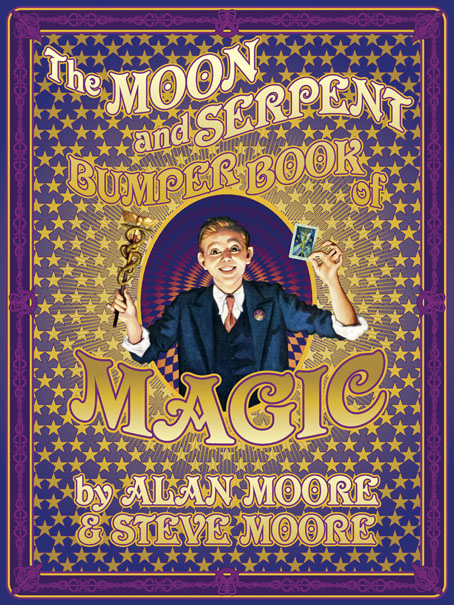
Top Shelf announced this one on Friday so I can break my silence about the book I’ve been working on since May 2021. The Moon and Serpent Bumper Book of Magic by Alan Moore and Steve Moore was first announced in February 2007. I’d created the cover design which was used for promotional purposes after which the project went into hibernation for several years. In 2014 Alan and Steve were back at work again, and were co-writing the final essay when Steve died suddenly in March of that year, whereupon the book retreated to limbo once more. Since 2007 my cover has been floating around the internet like the lid for an empty toybox, but the book really is finished at last, and will be published by Knockabout (UK) and Top Shelf (US) in October.
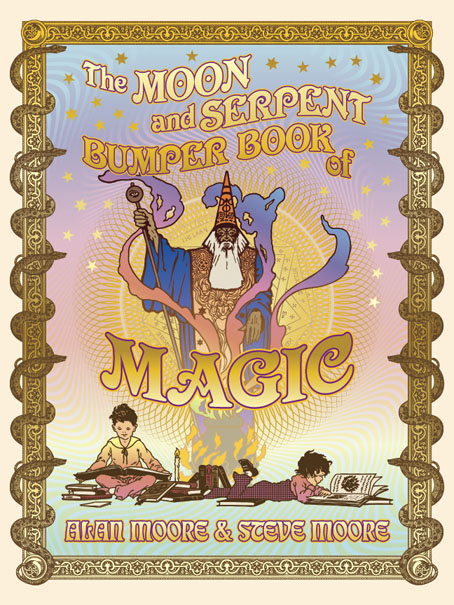
In addition to the cover design I was also slated to be working on two of the book’s internal features: The Soul, a six-part illustrated serial set in the 1920s which evolved out of the occult-detective strip that Alan and I were planning circa 1999; also a series of twenty full-page illustrations for a feature titled Magical Landscapes. When Tony at Knockabout informed me at the beginning of 2021 that the book was being revived I made the audacious suggestion to him and to Alan that I could, if need be, design the whole thing as well as illustrate my own sections. Alan readily agreed, saying he trusted me implicitly, which was good to hear; his sole brief was that the book should be “beautiful and psychedelic”. One reason for his trust is that we’d already made excursions into the Moon & Serpent zone together. I designed three of the Moon & Serpent CDs in the 2000s, and made the video that accompanied the William Blake-themed reading/performance by Alan and co. at the Purcell Room, London, in 2001. Consequently, I’ve often felt like a floating member of the Moon & Serpent cabal.
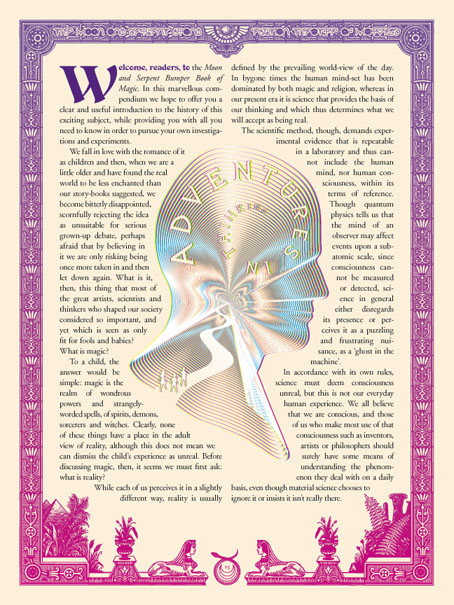
A couple of things are worth noting now that the book is about to enter the world. The first is that the contents are a little different to the press release from 2007 which announced a book of 320 pages, with 78 of those pages being brand new Tarot card designs. The authors subsequently realised that creating an entirely new Tarot deck is a huge task in itself, especially if, as was the intention, you wanted it to be as wide-ranging and authoritative as the Crowley/Harris Thoth deck. There is a chapter about the Tarot in the finished book but readers will now have to choose decks of their own. I can imagine disappointment being expressed about this, and about some of the other changes but the book as it now stands is actually bigger than the original proposal, with an additional 32 extra pages. The expansion is partly a result of my page design which put fancy borders on all of the text pages. I ended up doing a lot more work for the book than I expected, adding new pages here and there, creating a lot of extra graphics and illustrations, and breaking up the long final essay into sections which are illustrated throughout with small pictures.
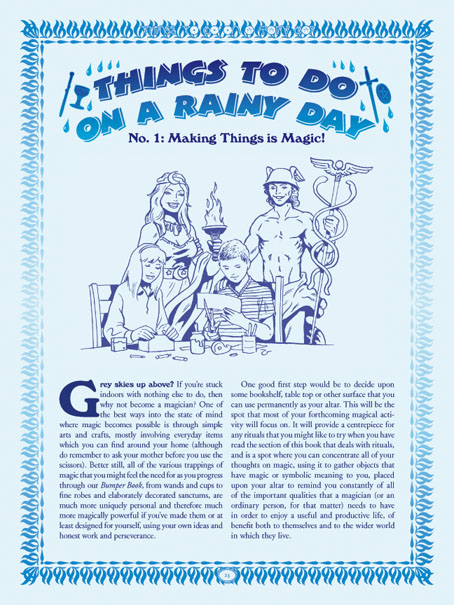
Art by Rick Veitch.
The other thing to note is that this book is as much Steve Moore’s as Alan Moore’s, something which I’m sure Alan will want to emphasise but which news reports and reviews are inevitably going to overlook. The aforementioned final essay, “The Moon and Serpent: An Evening in the Grand Egyptian Theatre of Marvels” is a piece that functions on three levels: first as a recapitulation of the book as a whole, second as a history of the development of magical thought, and third as a brief history of the Moon & Serpent cabal itself, together with a précis of the cabal’s magical philosophy. This latter aspect includes a sketch of Alan and Steve’s long-running friendship which makes the point that it was Steve Moore who first interested Alan Moore in magic as something to be involved in more deeply than mere intellectual interest. I was surprised to discover that the pair first began talking about magic after Steve introduced Alan to the Illuminatus! trilogy in the 1970s; Robert Shea and Robert Anton Wilson’s books also stoked my own interest in magic at the same time, this being a subject I was already curious about thanks to my Dennis Wheatley-reading mother. Alan and Steve didn’t formalise any of their occult preoccupations until the early 1990s but the Illuminatus! connection makes me feel that the Bumper Book might be seen as one of the long-tail artefacts generated by Shea and Wilson’s trilogy.
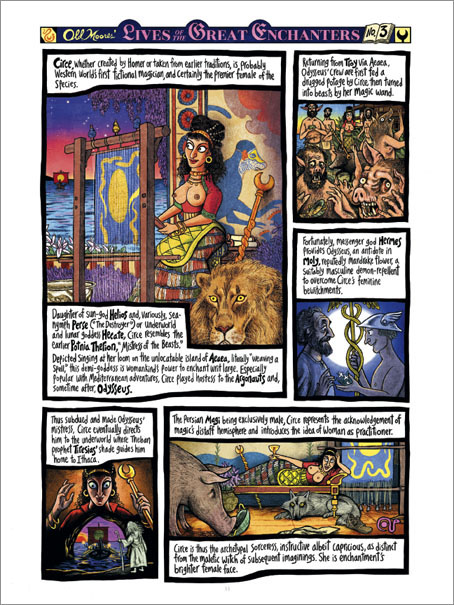
Art by Ben Wickey.
So why is all of this being presented in the form of a children’s book? “Why not?” would be the facetious answer but there are more specific reasons. The discussion and promotion of magic in the 21st century has a tendency to arrive in one of two stereotyped packages: New Age mysticism or Goth spookiness. Where grimoires are concerned (and the Bumper Book is by definition a grimoire) people often seem to take the “grim” part of the word as a style guide, even though “grimoire” is merely an old word meaning “grammar”. Many contemporary magic books, especially those that follow in the footsteps of Kenneth Grant, look as though they’re auditioning for a role in an HP Lovecraft story, with Latin titles and the kind of embossed sigils you see all the time on metal albums. Magic, like science and art, deals with the entirety of the world but you wouldn’t know it to look at a lot of the books that discuss the subject. Using the traditional children’s annual as a framing device means that the authors launch their ideas from a position of entertainment and aesthetic delight while at the same time being (relatively) serious and informative throughout. (This again reflects Illuminatus! which uses the form of a rambling SF-inflected adventure story to deliver a great deal of discussion about Discordianism, anarchism, occultism, weird fiction, American political history, etc, etc, most of which was news to me when I first read the trilogy at the age of 15). The Bumper Book may superficially resemble a children’s annual but this isn’t a book for children. The essays include discussion of the use of drugs and sex in magic, and there’s a lot of nudity (also a fair amount of sex) in the illustrations. The book is a serious study, but not, I hope, a boring one. Several of the features are presented in comic form, with eight of the pages being among the last works of the late Kevin O’Neill. Ben Wickey has done a fantastic job for the fifty pages of Old Moores’ Lives of the Great Enchanters which runs throughout the book and covers the entire history of Western magical thought from the Stone Age to the present day. There’s a lot of aesthetic pastiche at work here (Alan loves delivering his ideas in borrowed robes): Kevin’s pages are done in the style of the comics strips seen in Radio Fun and Film Fun—popular British children’s comics of the 1940s and 50s—while Ben’s strips adopt the format of the old Ripley’s Believe It or Not! strips. Regular { feuilleton } readers won’t be surprised to learn that my own contributions lean heavily on Art Nouveau as well as the required psychedelic flourishes. I was especially pleased to have an opportunity to use many of the fonts that I wrote about in this post.
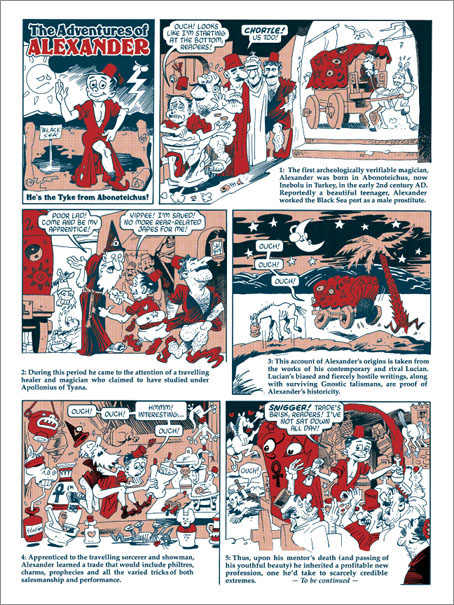
Art by Kevin O’Neill.
I could say more about the contents but I’m not going to spoil things. I’ve been immensely grateful to Alan, Tony and Chris at Top Shelf for not pressuring me to get this one finished. I’m often complaining that publishers don’t give you enough time to work on things but that wasn’t the case with this book. I just wish Steve Moore was still here to see it (and Kevin O’Neill, an artist whose work I always admired but I never got to meet). October this year is going to be lunar and serpentine. We’ll see you in the Theatre of Marvels.
Previously on { feuilleton }
• The most unusual magazine ever published: Man, Myth and Magic
• Jan Parker’s witches
• Émile Bayard’s Histoire de la Magie
• Typefaces of the occult revival
• De Plancy’s Dictionnaire Infernal
• Dreaming Out of Space: Kenneth Grant on HP Lovecraft
• The Occult Explosion
• Wilfried Sätty: Artist of the occult

“Magic, like science and art, deals with the entirety of the world but you wouldn’t know it to look at a lot of the books that discuss the subject.” Yes indeedy… I think this is one of the attractions of surrealism, in that it likewise deals with magic from many different and stimulating vantage points.
This is certainly a year for good books. Here’s a list that some may find worthwhile:
June: Think to New Worlds: The Cultural History of Charles Fort and His Followers by Joshua Blu Buhs.
An Exorcism – A Photo Romance by Penny Slinger.
August — Chapel Perilous: The Life and Thought Crimes of Robert Anton Wilson by Gabriel Kennedy.
September — Magic Art [1st English translation] by André Breton.
October — Surrealism and the Tarot: A Love Story edited by Tessell Baudin.
This looks great, and it sounds like you had a fantastic time working on it.
I can see a little bit of Alphonse Mucha and Winsor McCay, and a great Egyptian Revival border on one page.
Your illustrations look great; the first captures the look of the posters advertising various magicians from the early 20thC (Kellar, Carter, Thurston, Karlini etc.) and the second really has a Windsor McKay/P. Craig Russell vibe to it. I used to have a set of the Italian Aquarian Tarot that I got around 1980, but lost them over time. I would have loved to have the ones printed in ‘Oz’ magazine designed by Martin Sharp (which they never released as a set, I gather; if he even did a whole set).
Looking forward to the book.
Wondrous news all-round, John ??
This is great news, and congratulations are in order for all involved!
I have the impression that you yourself have designed a set of tarot cards for some other project, perhaps you might find opportunity in the near future to release it again?
I look forward to the publication, John – looks amazing.
Off topic, but knowing of your interest in graphic art, old and, new you may wish to check out the online catalogue I came across for a Swann auction – link below –
https://catalogue.swanngalleries.com/auction-catalog/VINTAGE_POSTERS_GRAPHIC_DESIGN?saleno=2660&orderby=1&utm_source=Colossal&utm_medium=retargeting&utm_campaign=2660&utm_content=600×1200
Lives of the Great Enchanters looks reminiscent of Lives of the Great Occultists, a single page strip which Hunt Emerson used to do in Fortean Times. I’m sure Moore must be aware of that strip, so perhaps it’s a deliberate homage?
Thanks, everyone!
Paul: Ta for the book tips. Those are all news to me. Penny Slinger’s Oracle gets a mention in the BBOM essay about the Tarot.
Jim/Modzilla: Those kids on the title page were borrowed from an old children’s magazine; I didn’t really have Winsor McCay in mind although I can see why you’d think that. I thought the magazine was a suitably obscure source then was irritated to fins the same drawings in one of the Dover Pictorial Archive books. I try to avoid using the Dover books these days if I can find less obvious sources. I don’t think Martin Sharp ever did an entire Tarot deck. Everyone (me included) tends to do the Major Arcana then skip the chore of doing all the spot cards as well.
Johann: Yes, I did this set in 2006:
https://www.johncoulthart.com/pantechnicon/tarot.html
I ended up using them to help illustrate the Tarot section in the book. One of the problems with Tarot cards is that so many of them are under copyright in various countries so this was a convenient solution. I do keep thinking of doing the rest of the cards for my set but the restraints of the design don’t make this easy.
Andimac: Thanks, there’s quite a few designs there I haven’t seen before.
Paul Slade: I think the Old Moores’ strips are multi-valent, to use a technical term. Alan will, of course, know about Hunt Emerson’s strips (I think Knockabout have done a collection of them), while Steve Moore was the editor of Fortean Times for a while, and may even have commissioned Emerson in the first place. The main reason for the Old Moores’ section is that it reflects the tradtion of books about magic featuring sections which discuss the history of the magical arts and the lives of prior practioners. Francis Barrett’s The Magus does this, and I think one of the Paracelcus books does the same. This section brings the history up to the present day.
Amazing. I remember this being first announced and then it being shelved and when Steve Moore died I thought it’d probably never see the light of day. Can’t wait to check it out tbh. x